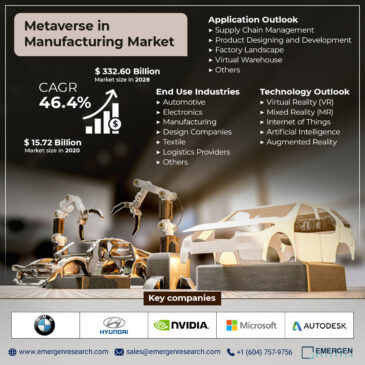![]()
Increasing efforts by customer-centric firms to provide emotionally engaging experiences to customers is a key factor driving revenue growth in the global digital human avatar market.
According to Emergen Research, the global digital human avatar market is expected to reach USD 527.58 billion in 2030, with a revenue CAGR of 46.4% over the forecast period. Increased efforts by customer-centric firms to provide emotionally engaging experiences to customers can be attributed to robust global digital human avatar market revenue growth. The integration of conversational intelligence into a virtual human avatar allows for scalable interaction between a human being and the avatar, allowing for a more directed approach to understanding a customer’s needs.
Digital human avatars can converse with customers via text or speech to provide product recommendations. Furthermore, these avatars can assist visitors in navigating a product catalogue and proactively mimic a salesperson by initiating a conversation in any language, and subsequently understand consumer preferences via their responses based on a prebuilt algorithm, in order to provide appropriate responses to a customer’s queries.
Another factor driving demand for digital human avatars or virtual idols is the growing number of contact centres, as employing customer care executives to handle customer queries via chats and live replies is an expensive and time-consuming process. This, as well as the management of scenarios in which customers may not receive a response to their queries for unknown reasons, is driving the deployment of digital avatars. A virtual Artificial Intelligence (AI) avatar contains a wealth of information that, when processed using pre-programmed algorithms, enables it to resolve any discrepancy or query that a customer may have.
Furthermore, these avatars can respond to customer queries much faster than live human agents and are considered extremely useful in situations where managing a large query inflow to be resolved by a fixed number of live human agents becomes humanly impossible. A digital human can rely on a single cloud function to handle multiple queries from multiple visitors, resulting in relatively efficient and rapid query resolution.
Some of the Report’s Key Findings
The interactive digital human avatar segment is expected to grow at a faster rate than the other product type segments over the forecast period. In comparison to virtual agents, who understand and learn customer behaviour in real-time and rapidly adapt to create a completely personalised approach to each customer, live human agents who follow a standard set of queries are more likely to struggle at forming an interactive environment in terms of personalised approach. In addition to interacting with customers via tailored queries and responses, digital human avatars can develop a personalised consumer-specific algorithm for learning the patterns of their selections and choices. Furthermore, businesses can use these avatars for online training and learning of their employees.
Among the industry vertical segments, revenue in the IT & telecommunications segment is expected to grow rapidly over the forecast period. Rising demand for better connectivity services, as well as the emergence of 5G technology, are critical for the growth of telecom companies. However, contact centres are under tremendous strain and are struggling to scale as needed. Furthermore, scalable automated technologies such as chatbots are unable to replicate critical human touch in providing customer experience. As a result, customers are suffering from digital fatigue, with 82% preferring to speak with a live person. Digital human avatars provide a more human-like experience to customers, allowing telecom companies to scale the human touch while freeing up human staff to focus on other tasks.
The Asia Pacific digital human avatar market is expected to grow at the fastest rate during the forecast period, owing to rising demand for digital human avatars in end-use industries such as retail, media & entertainment, banking, healthcare, and education in countries such as China, South Korea, Australia, and Japan. China’s digital human avatar market revenue is expected to grow at the fastest rate during the forecast period.
DeepBrain AI, a Seoul, South Korea-based startup that provides conversational AI-based solutions, announced in August 2021 that it had raised USD 44 million in a series B round, which would be used to expand the company’s global customer base and operations globally, with a focus on the United States. Korea Development Bank led the funding. Deepbrain AI offers a variety of AI-powered customer service products, with a focus on synthetic humans, or digital human avatars that can respond to natural language questions.
Some major companies in the market report include UneeQ, Microsoft Corporation, Didimo Inc., Wolf3D, HOUR ONE AI, Spatial Systems, Inc., CARV3D, DeepBrain AI, Soul Machines, and Synthesia Ltd.
The global digital human avatar market has been segmented by Emergen Research based on product type, industry verticals, and region:
Product Type Outlook (Revenue, USD Billion; 2018–2030)
- Interactive Digital Human Avatar
- Non-Interactive Digital Human Avatar
Industry Verticals Outlook (Revenue, USD Billion; 2018–2030)
- BFSI
- Education
- Retail
- Healthcare
- Automotive
- IT & Telecommunications
- Gaming & Entertainment
- Others
Source Link: https://www.emergenresearch.com/industry-report/digital-human-avatar-market


